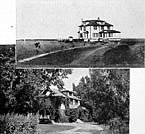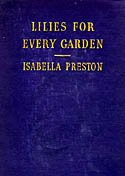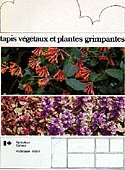Introduction
Planting the Seeds
Cultivating the Garden
The Cultivators
Horticultural Societies and Garden Clubs
Experimental Farms and Seed Nurseries
Botanical Gardens
Heritage Seeds and Gardening
Reaping the Harvest
Bibliography
Photos by Beth Powning
Other Gardening Sites
Acknowledgements |
The Cultivators
Experimental Farms and Seed Nurseries
The plants we grow have changed and developed, often dramatically, over the decades. One result has been a wider range of flowers, fruits and vegetables to choose from, and hardier plants more resistant to disease. Another result has been, somewhat ironically, the loss of many of the older varieties, the delicately scented and fragile flowers, the easily bruised but more flavourful vegetables. Two forces continue to reinforce this trend. The hybridizers and nurseries work to create plants that will withstand drought, fruits and vegetables that will ship without damage, and flowers of new colours and shapes. While those who wish to protect our heritage seeds and keep alive the gene pool from which our more modern plants have derived, encourage the growth of the valuable older seed stocks.
In the 19th century, gardeners and farmers gained most of their information about plants from friends, the few available books, newspapers and periodicals. More formal help became available in 1886 when the Department of Agriculture established the Central Experimental Farm just outside Ottawa (now within the city limits), and subsequently a number of experimental farms or stations across the country. Two years later, James Fletcher began work on the arboretum and botanical garden. Under the Dominion Horticulturalist, William T. Macoun (famous for his own beautiful perennial border at the Farm), the staff developed hardy strains of plants that would survive in the Canadian climate. The famous Marquis wheat was one of their most successful contributions.

| "Research stations and experimental farms, or ‘The Farm,' as they are often still called in many of the communities where they are to be found across Canada, are different things to different people.... to local gardeners they are a place to go for friendly advice regarding their problem weeds or insects ... they are a delightful attraction in apple blossom or chrysanthemum seasons; to school children they are an extension of their science class or a place to picnic and hike..." |
Anstey, T.H.
One Hundred Harvests: Research Branch, Agriculture Canada, 1886-1986.
Ottawa: Agriculture Canada, 1986, p. xv. (Historical Series No. 27) |

| One of the biggest problems facing farming on the prairies was soil erosion from the winds which swept across the flat landscape. The fields of grain at the experimental stations were planted between rows of trees (shelter belts), producing attractive rows of trees and sturdy crops. Prairie homes too, as can be seen here, benefitted from the protection of trees. |
 |
Les Fermes experimentales fédérales: Un Demi-siècle de progrès, 1886-1936.
Ottawa: Impr. du Roi, 1939. |
| The hiring of Isabella Preston, the first woman hybridist in Canada, by the Central Experimental Farm, in 1920, marked the beginning of an emphasis on the breeding of flowering plants and shrubs. She created nearly 200 hybrids. Many of these were lilies, a flower in which she took a life-long interest. |
 |
Preston, Isabella.
Lilies for Every Garden.
New York: Orange Judd, 1947. |
| Trevor Cole was Dominion Arborist until his recent retirement. He has written a number of valuable books on gardening both for Agriculture Canada and for commercial publishers. |

|
Cole, Trevor J.
Tapis végetaux et plantes grimpantes.
Ottawa: Agriculture Canada, 1980. |
|
